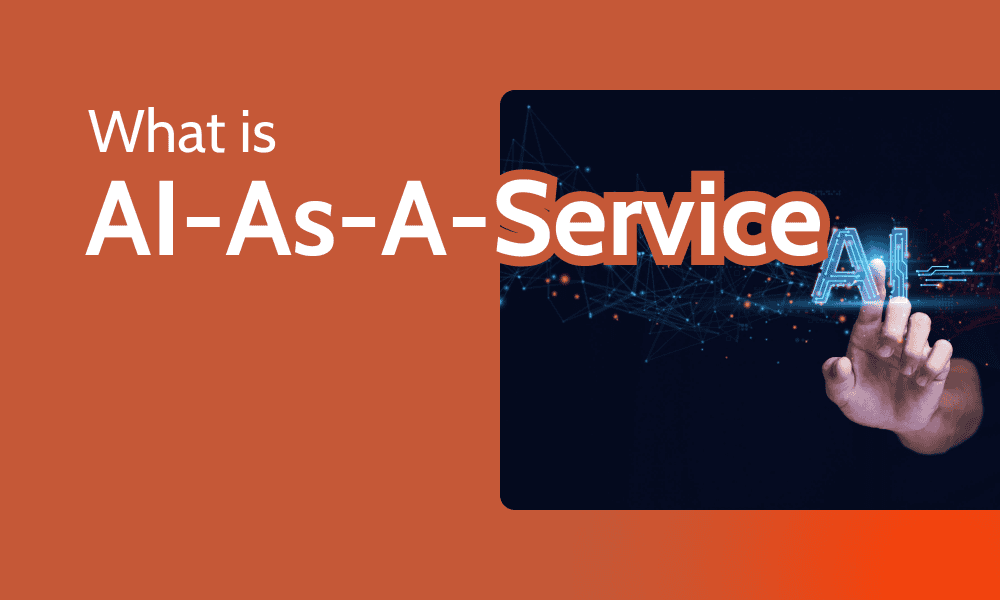One of the biggest upsides of AI-as-a-Service (AIaaS) solutions is their remote accessibility to AI. As long as you have an internet connection, you can access cutting-edge AI tools the moment they are available.
Beyond providing remote access to the latest artificial intelligence technologies, AIaaS offers other benefits, which we will discuss below. We’ll also look into how AIaaS works while exploring its components and key features.
What Is AIaaS?
AIaaS stands for Artificial Intelligence as a Service. It is a cloud service delivery model that offers prebuilt AI technologies for purposes such as video recognition, sentiment analysis, text analysis, chatbots and so on.
AIaaS solutions are designed to minimize the risks and costs associated with building AI models from scratch. They also help ensure faster time-to-market since they come preconfigured, allowing you to focus on other responsibilities.
How Does Artificial Intelligence as a Service Work?
AIaaS works by removing the financial responsibility involved with setting up the servers, storage and networks needed to run AI models. This is particularly important for complex AI models requiring high-performance, expensive infrastructure such as graphics processing units (GPUs), neural processing units (NPUs) and tensor processing units (TPUs).
Not only does AIaaS help you avoid the upfront costs of obtaining infrastructure, but it also minimizes overhead costs, particularly utilities. Running complex AI models often generates significant amounts of heat, which can raise your electricity and cooling bills. However, since the AI service provider manages the hardware, you won’t incur the cost of the utilities.
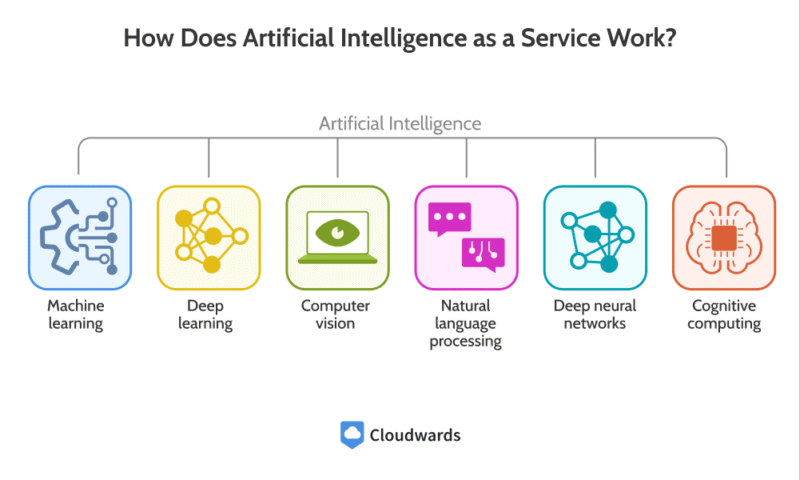
AI is created using various techniques, including machine learning, deep learning and natural language processing.
Besides offering infrastructure, AIaaS delivers pretrained AI models for various purposes, including language processing and image recognition. These models reduce development time since you can integrate them into your application without having to train them. AIaaS also provides ready-to-use AI-driven software built for end users, including chatbots and smart assistants.
AIaaS solutions may not always require a subscription, but you definitely need internet access to use them. Depending on your project, you can access them through web consoles, software development kits, cloud development kits and application programming interfaces (APIs).
AIaaS Components & Key Features
Naturally, one of the key features of AIaaS is the cloud infrastructure that supports it. However, other components like programmatic access, high-performance hardware and prebuilt models play significant roles in how AIaaS works.
Common AIaaS Types
Chatbots, machine learning services and copilots are some common types of AIaaS. As with many AIaaS solutions, they combine various branches of AI in their operations, which we will discuss below.
What Are the Benefits of AIaaS?
AIaaS reduces the barriers blocking access to AI tools, allowing people from all walks of life — not just IT professionals — to enter the industry. Beyond that, it offers the following benefits:
- Cost-effectiveness: As you’d expect of cloud services, AIaaS solutions charge based on usage, meaning you pay nothing when you aren’t using the resources. That aside, you can start out with little capital since you don’t have to invest in expensive hardware, especially CPUs, NPUs and TPUs.
- Scalability: AIaaS providers have massive computing resources that allow them to increase and decrease resources on demand, so they can cater to changes in your business operations in real time.
If you had to physically buy new servers whenever demand increased, it could take days for them to arrive. Even after delivery, these extra servers may become redundant after demand decreases.
- AI democratization: AI democratization makes AI accessible to those with various levels of technical skills, even non-IT professionals. AIaaS fosters this by offering ready-to-use AI software and pretrained AI models at pay-as-you-go rates. In other words, AIaaS allows you to use AI without having data scientists or a huge capital.
- Shifted focus: When you use AIaaS, you’re pretty much outsourcing the infrastructure management and AI models used to build your services. Of course, this means you have fewer responsibilities and can focus on other tasks.
- Enhanced productivity: AIaaS tools generally increase productivity. For one, copilots offer real-time suggestions that help you get work done faster. Furthermore, customer service chatbots take care of routine inquiries from customers, letting the human agents handle more complicated requests.
Potential Challenges of AI as a Service
AI has affected the ecological and social fabric of our world. These effects are not without challenges, which include the following aspects:
- Environmental impact: AI systems — particularly generative AI models — are notorious for consuming large amounts of energy and water, resulting in significant carbon footprints. For these reasons, many people oppose the adoption of AI, especially for casual purposes.
- Data privacy concerns: Many AIaaS providers claim to use stringent security measures that comply with regulatory standards. However, users still worry about data privacy. This is understandable because some AI tools, like smartwatches or large language models (LLMs), collect sensitive data to enhance personalization or to further train the tool.
- Ethical concerns: AI trained on biased data will echo those biases, leading to unfair outcomes in its operations. When negative outcomes occur, it’s unclear who should face the consequences. Furthermore, people can use AI models (especially generative AI) to spread misinformation, falsify evidence and alter reality in all sorts of malicious ways.
- Limited control: Similar to the Infrastructure-as-a-Service (IaaS) delivery model, an AIaaS solution’s architecture is largely abstracted from you. For this reason, your ability to customize, troubleshoot and update the service is limited. In other words, you must rely on the provider to handle anything under the hood.
- Incompatible legacy systems: If you intend to integrate AIaaS with older systems, you may have to revamp them due to incompatibility issues. This process could require a lot of effort and significant capital.
Examples of AIaaS Companies
Many top cloud service providers are AIaaS companies, including Amazon Web Services (AWS), Microsoft Azure, Google Cloud and Salesforce. Here’s an overview of what they offer.
1. Amazon Web Services (AWS)

Amazon Polly has four engines: generative, neural, long-form and standard.
Besides having one of the largest cloud service catalogs, AWS offers many AIaaS tools, including Amazon SageMaker, Amazon Rekognition, Amazon Lex and Amazon Q.
Amazon SageMaker is an AI platform for developing, training and deploying machine learning models. Additionally, Amazon Rekognition is a computer vision service that performs visual analysis and identifies objects in images and videos. Amazon Lex builds conversational AIs, while Amazon Q is a generative AI assistant.
2. Microsoft Azure
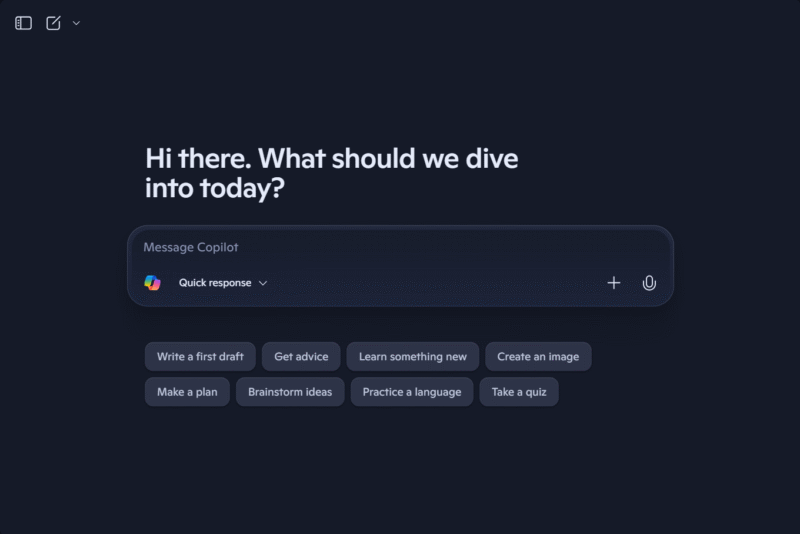
While Microsoft Copilot is an AI assistant, Microsoft Copilot
Studio is a platform for building copilots.
Microsoft Azure offers Azure Machine Learning, which is comparable to Amazon SageMaker. It also has many other services, including an AI assistant named Microsoft Copilot, a no-code bot builder called Azure AI Bot Service, and an AI-based indexing service known as Azure AI Search.
3. Google Cloud
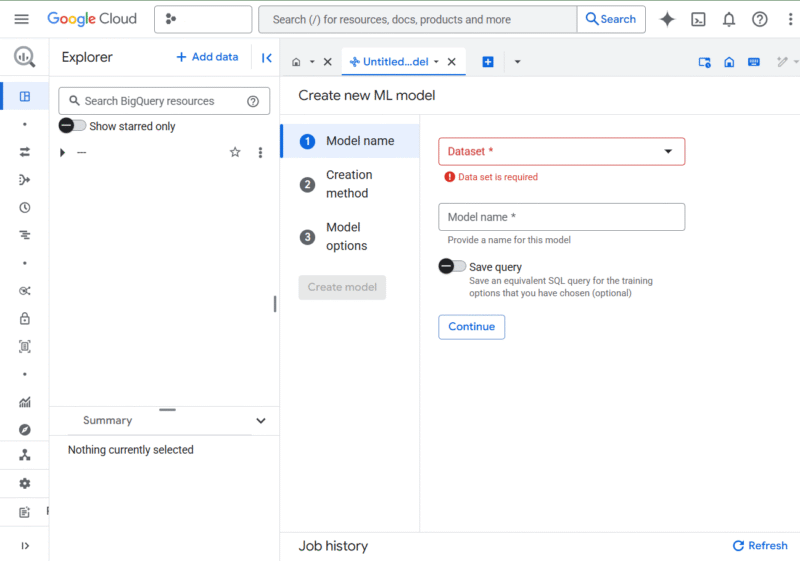
BigQuery ML supports machine learning algorithms like linear regression,
K-means clustering and principal component analysis.
Google Cloud’s AI and data services — particularly its BigQuery suite — are highly regarded. BigQuery is an autonomous service that streamlines the data-to-AI pipeline. It offers subservices like BigQuery ML, which is similar to Azure Machine Learning and Amazon SageMaker. You’ll also find other AIaaS, such as Gemini, Vertex AI and Document AI.
4. Salesforce
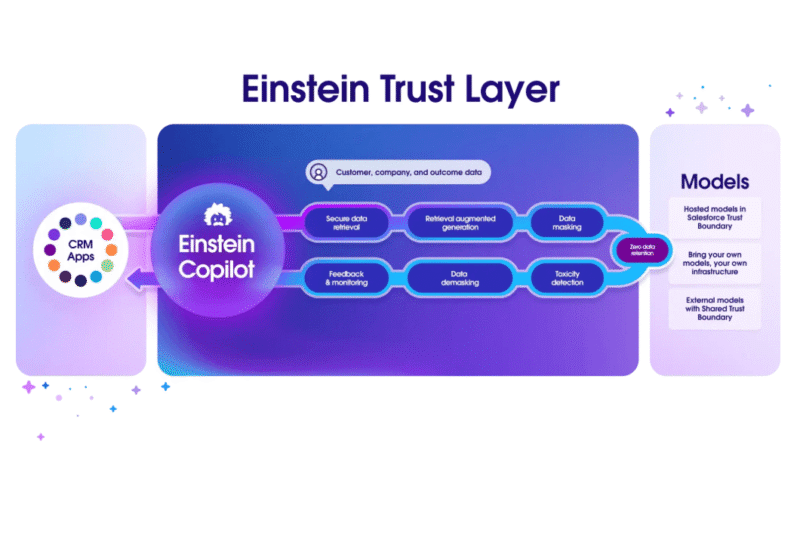
Salesforce Einstein offers tools like Einstein Discovery,
which analyzes historical data for predictive analysis.
Salesforce offers AIaaS through an umbrella service called Einstein AI. It serves various purposes, including bot creation, predictive analytics, data analysis, pattern recognition, AI agent customization, autonomous marketing and AI assistant generation.
5. OpenAI
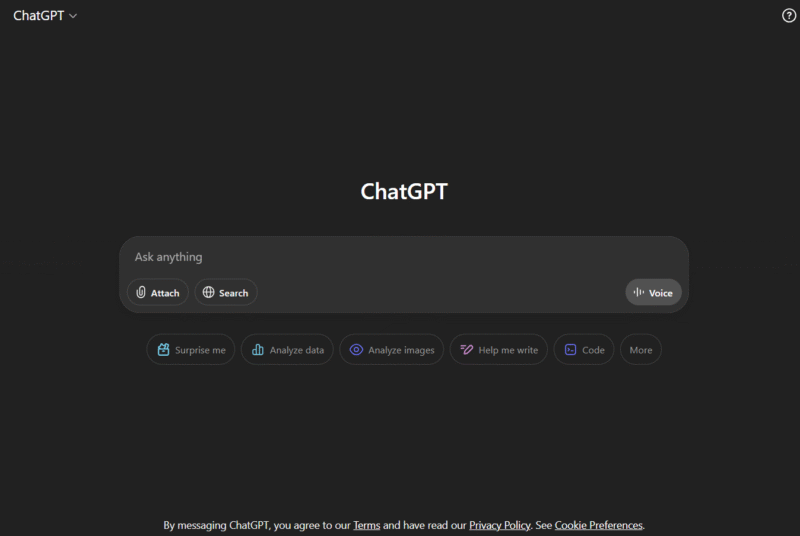
ChatGPT is a generative AI that helps with various tasks, including writing,
coding, having conversations and analyzing images.
OpenAI is known for developing one of the most popular generative AI assistants: ChatGPT. However, it also offers other AIaaS solutions, including DALL-E, ChatGPT Search, Sora and Whisper.
What Does the Future Look Like for AI as a Service?
AIaaS is the future of cloud service delivery as it is primed to integrate extensively with solutions like IaaS, PaaS and SaaS. You can expect it to become even more embedded in cloud services as its user-friendly nature enables more users to access AI.
The push toward wider AIaaS adoption will usher in enhanced personalization. As AIaaS consumes more user data, it will provide increasingly unique experiences at an individual level. Of course, this will also pose privacy and security risks, but implementing strong ethical frameworks will help you mitigate them.
Final Thoughts
AIaaS is one of the main reasons behind the rapid growth and wide adoption of AI in cloud computing, giving everyone easy access to these services. Many ethical, ecological and privacy concerns still remain, but we’ll have to wait and see how these will be addressed as the global AI industry continues to grow.
Which AIaaS do you use in your daily routine, and what do you use it for? Have you considered trying different alternatives? If not, why? Share your thoughts with us in the comments below, and as always, thank you for reading.
FAQ: AI Services
-
AI is not replacing SaaS; rather, it’s being integrated into SaaS solutions to enhance them.
-
Yes, ChatGPT is AI as a Service. It is a cloud-based solution that requires an internet connection to access it.
-
The four types of AI are self-aware AI, limited memory AI, reactive machines and theory of mind AI.
-
Providers like AWS, Google Cloud, Microsoft Azure, Salesforce, IBM, Oracle and OpenAI offer AIaaS.
Sources:
- McKinsey — The State of AI: How Organizations Are Rewiring to Capture Value

